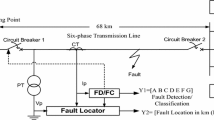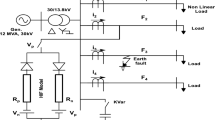Abstract
In this paper, the proposed wavelet-based methodology is developed to identify and classify the High Impedance Fault (HIF) in the Power Distribution System (PDS). The planned technique is based on the combination of Ant Lion Optimizer (ALO) and Artificial Neural Network (ANN), which is performed to accurately isolate the HIF. The change in phase current waveforms caused by faults and normal switching events has been used in this methodology. In order to develop the method to detect high impedance arcing faults under the linear conditions. The faults are identified through the computation of the basic electric descriptions of current and voltage signals. From the voltage and current signals, the harmonic components also computed. From the voltage, current signals, the fault are identified and classified in the system which can be able to solve the problem in the system. The harmonics level also analyzed which also detected and able to correct it for enabling the stable operation in the system. ANN is an Artificial Intelligence (AI) method that applied for optimizing precise generation limits as blocking happened. The neural network contains two stages: training stage and testing stage. Here, the ALO algorithm is utilized to improve the performance of the ANN training process. ALO is a new nature-inspired algorithm mimicking the hunting behavior of ant lions. The design of Lifting Wavelet Transform (LWT) is suitable for the classification process. The main objective of ANN with the aid of the ALO algorithm is the detection and classification of the HIF in PDS and analyzed the delay time of different locations. From the evaluation of the proposed technique, the inputs and their corresponding outputs are noted. The performance of the work is implemented in MATLAB/Simulink platform and the presentation of this model is investigated on the basis of the two cases of analysis. The results show that the projected algorithm detects the HIFs accurately and compared with the existing methods ALO, GSA and ANN, and GA and Fuzzy, respectively.












Similar content being viewed by others
Abbreviations
- HIF:
-
High impedance fault
- PDS:
-
Power distribution system
- AI:
-
Artificial intelligence
- LWT:
-
Lifting wavelet transform
- DG:
-
Distributed generators
- LDCs:
-
Local distribution companies
- SCADA:
-
Supervision control and data acquisition
- ANN:
-
Artificial neural network
- IDE:
-
Integrated development environment
- PQDSZ:
-
Quasi-differential zero sequence protection
- MV:
-
Medium-voltage
- ALO:
-
Ant lion optimizer
- MLP:
-
Multilayer perceptron
- BP:
-
Back-propagation
- MSE:
-
Mean square error
- \(V_{q\left( k \right)}^{abc}\) :
-
\(V_{{q\left( {HIF} \right)}}^{abc}\)HIF fault voltages
- \(Z_{qq}^{abc}\) :
-
Driving point impedance
- \(Z_{HIF}^{abc}\) :
-
HIF fault impedance
- \(\,I_{HIF}^{abc}\) :
-
HIF fault current
- \(V_{{g\left( {HIF} \right)}}^{abc}\) :
-
Voltage HIF fault point g
- \(F\left( S \right)\) :
-
Fitness function
- \(\alpha_{i} = \left\{ {\alpha_{1} ,\,\alpha_{2\,,\,} ....\alpha_{N} } \right\}\) :
-
ANN output
- \(N_{H\,}\) :
-
Number of hidden neurons
- \(d_{OUT}\) :
-
Output from jth output neuron
- \(w_{ij}\) :
-
Weight of i–j link of the network
- \(\alpha_{i}\) :
-
Output of ith the hidden neurons.
- \(c\) :
-
Input variable
- \(\eta\) :
-
Learning rate
- \(\gamma^{t}\) :
-
Minimum of all variable of tth variable
- \(\lambda^{t}\) :
-
Maximum of all variables in tth an iteration
- \(t\) :
-
Current iteration
- \(Antlion_{j}^{t}\) :
-
Position of selected jth ant-lion at tth iteration
- \(Ant_{j}^{t}\) :
-
Position of ith ant at tth iteration
- \(RM_{antlion}^{t}\) :
-
Random walk around the antlion selected using the roulette wheel at tth iteration
- \(R_{Elite}^{t}\) :
-
Random walk around the elite at tth iteration
References
Bisht T (2012) Power quality in grid with distributed generation. Int J Trends Econ Manag Technol 1:6
Chandrasekaran K, Vengkatachalam PA, Karsiti MN, Rama Rao KS (2009) Mitigation of power quality disturbances. Int J Theor Appl Inf Technol 20:105–116
Polajzer B, Stumberger G, Dolinar D (2015) Detection of voltage sag sources based on the angle and norm changes in the instantaneous current vector written in Clarke’s components. Int J Electr Power Energy Syst 64:967–976
Moreno-Munoz A, de-la-Rosa JJG, Lopez-Rodriguez MA, Flores-Arias JM, Bellido-Outerinoa FJ, Ruiz-de-Adanac M (2010) Improvement of power quality using distributed generation. Int J Electr Power Energy Syst 32:1069–1076
Prodanovic M, Green TC (2006) High-quality power generation through distributed control of a power park microgrid. IEEE Trans Ind Electron 53(5):1471–1482
Khadem SK, Basu M, Conlon M (2012) Integration of UPQC for power quality improvement in distributed generation network—a review. Int J Emerg Electr Power Syst 13:1
Vaimann T, Niitsoo J, Kivipold T, Lehtla T (2012) Power quality issues in dispersed generation and smart grids. Elektron IR Elektrotechn 18(8):23–26
Janjic A, Stajic Z, Radovic I (2011) Power quality requirements for the smart grid design. Int J Circ Syst Signal Process 5:6
Amin M (2004) Balancing market priorities with security issues. IEEE Trans Power Energy Mag 2(4):30–38
Nafisi H, Agah SMM, Askarian Abyaneh H, Abedi M (2016) Two-stage optimization method for energy loss minimization in micro grid based on smart power management scheme of PHEVs. IEEE Trans Smart Grid 7(3):1268–1276
Vasundhara V, Khanna R, Kumar M (2013) Improvement of power quality by UPQC using different intelligent controls: a literature review. Int J Recent Technol Eng 2(1):173–177
Roncero JR (2008) Integration is key to smart grid management. Int J Smart Grids Distrib 20:1–4
Lin S-Y, Chen J-F (2013) Distributed optimal power flow for smart grid transmission system with renewable energy sources. Int J Energy 56:184–192
Paudyal S, Canizares CA, Bhattacharya K (2011) Optimal operation of distribution feeders in smart grids. IEEE Trans Ind Electron 58(10):4495–4503
Kabalci E, Kabalci Y, Develi I (2012) Modelling and analysis of a power line communication system with QPSK modem for renewable smart grids. Int J Electr Power Energy Syst 34:19–28
Hashemi-Dezaki H, Askarian-Abyaneh H, Haeri-Khiavi H (2016) Impacts of direct cyber-power interdependencies on smart grid reliability under various penetration levels of micro turbine/wind/solar distributed generations. IET Trans Gener Transm Distrib 10(4):928–937
St Leger A, James J, Frederick D (2012) Smart grid modeling approach for wide area control applications. IEEE J Power Energy Soc Gener Meet
Brenna M, Faranda R, Tironi E (2009) A new proposal for power quality and custom power improvement: OPEN UPQC. IEEE Trans Power Deliv 24(4):2107–2116
Bollen M (2011) Adapting electricity networks to a sustainable–smart metering and smart grids. Int J Swed Energy Mark Inspect 20:1–115
Zamora-Cardenas EA, Fuerte-Esquivel CR, Pizano-Martinez A, Estrada-Garcia HJ (2016) Hybrid state estimator considering SCADA and synchronized phasor measurements in VSC-HVDC transmission links. Int J Electr Power Syst Res 133:42–50
Thomas MS, Bhaskar N, Prakash A (2016) Voltage based detection method for high impedance fault in a distribution system. Int J Inst Eng 97(3):413–423
Chen J, Phung T, Blackburn T, Ambikairajah E, Zhang D (2016) Detection of high impedance faults using current transformers for sensing and identification based on features extracted using wavelet transform. IET Trans Gener Transm Distrib 10(12):2990–2998
Gabr MA, Ibrahim DK, Ahmed ES, Gilany MI (2017) A new impedance-based fault location scheme for overhead unbalanced radial distribution networks. Int J Electr Power Syst Res 142:153–162
Mo Dehghani MH, Khooban TN (2016) Fast fault detection and classification based on a combination of wavelet singular entropy theory and fuzzy logic in distribution lines in the presence of distributed generations. Int J Electr Power Energy Syst 78:455–462
Santos WC, Lopes FV, Brito NSD, Souza BA (2017) High-impedance fault identification on distribution networks. IEEE Trans Power Deliv 32(1):23–32
Koley E, Kumar R, Ghosh S (2016) Low cost microcontroller based fault detector, classifier, zone identifier and locator for transmission lines using wavelet transform and artificial neural network: a hardware co-simulation approach. Int J Electr Power Energy Syst 81:346–360
Vianna JTA, Araujo LR, Penido DRR (2016) High impedance fault area location in distribution systems based on current zero sequence component. IEEE Latin Am Trans 14(2):759–766
Nikander A, Jarventausta P (2017) Identification of high-impedance earth faults in neutral isolated or compensated MV networks. IEEE Trans Power Deliv 32(3):1187–1195
Mahari A, Seyedi H (2015) High impedance fault protection in transmission lines using a WPT-based algorithm. Int J Electr Power Energy Syst 67:537–545
Sheng Y, Rovnyak SM (2004) Decision tree-based methodology for high impedance fault detection. IEEE Trans Power Deliv 19(2):533–536
Tonelli-Neto MS, Guilherme J, Decanini MS, Lotufo ADP, Minussi CR (2017) Fuzzy based methodologies comparison for high-impedance fault diagnosis in radial distribution feeders. IET Trans Gener Trans Distrib 11(6):1557–1565
Dubey HM, Pandit M, Panigrahi BK (2016) Ant lion optimization for short-term wind integrated hydrothermal power generation scheduling. Int J Electr Power Energy Syst 83:158–174
Thukaram D, Khincha HP, Vijaynarasimha HP (2005) Artificial neural network and support vector machine approach for locating faults in radial distribution systems. IEEE Trans Power Deliv 20(2):710–721
Momeni E, Armaghani DJ, Hajihassani M, Amin MFM (2015) Prediction of uniaxial compressive strength of rock samples using hybrid particle swarm optimization-based artificial neural networks. Int J Meas 60:50–63
Baqui I, Zamora I, Mazon J, Buigues G (2011) High impedance fault detection methodology using wavelet transform and artificial neural networks. Int J Electr Power Syst Res 81:1325–1333
NengLing T, JiaJia C (2008) Wavelet-based approach for high impedance fault detection of high voltage transmission line. Eur Trans Electr Power 18(1):79–92
Balser S, Clements K, Lawrence D (1986) A microprocessor-based technique for detection of high impedance faults. IEEE Trans Power Deliv 1(3):252–258
Sedighi A-R, Haghifam M, Malik O, Ghassemian M-H (2005) High impedance fault detection based on wavelet transform and statistical pattern recognition. IEEE Trans Power Deliv 20(4):2414–2421
Russell BD (1990) Computer relaying and expert systems: new tools for detecting high impedance faults. Electr Power Syst Res 20(1):31–37
Sedighi A-R, Haghifam M-R, Malik O (2005) Soft computing applications in high impedance fault detection in distribution systems. Electr Power Syst Res 76(1–3):136–144
Samantaray SR, Dash PK (2010) High impedance fault detection in distribution feeders using extended Kalman filter and support vector machine. Eur Trans Electr Power 20(3):382–393
Livani H, Evrenosoglu C (2014) A machine learning and wavelet-based fault location method for hybrid transmission lines. IEEE Trans Smart Grid 5(1):51–59
Sahoo S, Baran ME (2014) A method to detect high impedance faults in distribution feeders. In: T D conference and exposition. 2014 IEEE PES, pp 1–6
Sulaiman M, Tawafan A, Ibrahim Z (2012) High impedance fault detection on power distribution feeder. Int Rev Modell Simul 5(5):2197–2204
Sulaiman M, Tawfan A, Ibrahim Z (2013) Detecting high impedance fault in power distribution feeder with fuzzy subtractive clustering model. Aust J Basic Appl Sci 7:81–91
Author information
Authors and Affiliations
Corresponding author
Additional information
Publisher's Note
Springer Nature remains neutral with regard to jurisdictional claims in published maps and institutional affiliations.
Rights and permissions
About this article
Cite this article
Narasimhulu, N., Kumar, D.V.A. & Kumar, M.V. LWT Based ANN with Ant Lion Optimizer for Detection and Classification of High Impedance Faults in Distribution System. J. Electr. Eng. Technol. 15, 1631–1650 (2020). https://doi.org/10.1007/s42835-020-00456-z
Received:
Revised:
Accepted:
Published:
Issue Date:
DOI: https://doi.org/10.1007/s42835-020-00456-z




